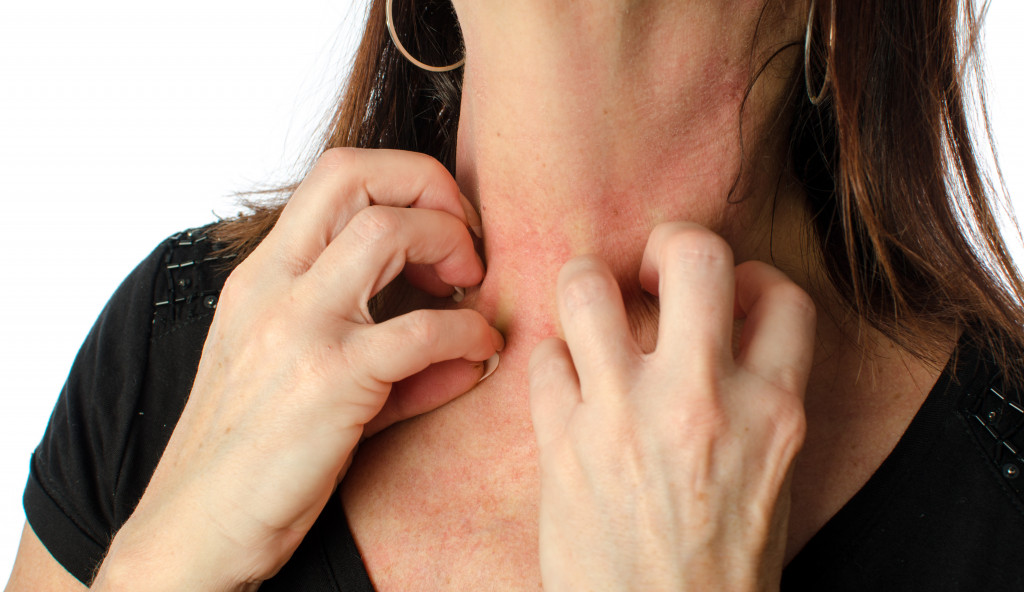- Rashes are red, itchy, and swollen patches on the skin that allergens, chemical irritants, and stress can trigger.
- To avoid rashes, identify and avoid potential allergens or irritants. Wear loose-fitting clothes made of breathable fabrics and practice good hygiene.
- If you have a rash already, keep the area clean and apply cool compresses.
- To prevent rashes, keep your clothes clean and dry clean if necessary.
- Understanding the common triggers for rashes helps you find suitable treatments to reduce their occurrence and keep your skin healthy.
Rashes are a common skin condition affecting people of different skin types, ages, and genders. They appear red, itchy, and swollen patches on the skin and can be triggered by several factors. Identifying the cause of your rash is one of the most important steps toward finding a suitable treatment plan.
What Are Rashes?
Skin rashes are common skin conditions characterized by changes in the appearance or texture of the skin. They can vary in their appearance, ranging from red, inflamed patches to raised bumps, blisters, or scaly areas. Skin rashes can occur anywhere on the body and may be accompanied by itching, pain, or other symptoms. There are various reasons for rashes. Here are some of them:
Allergens
Allergens are substances that trigger an allergic reaction in your body. Common household allergens include dust, pollen, pet dander, and certain foods. When you come in contact with an allergen, your body releases a chemical called histamine, which causes inflammation and itching. To avoid allergic rashes, try to identify and avoid the suspected allergen. You can also take OTC antihistamines or topical creams to relieve the symptoms.

Chemical Irritants
Exposure to chemicals and irritants at home can also cause rashes on your skin. Common chemical irritants include laundry detergents, cleaning agents, and personal care products such as shampoos and perfumes. If you suspect that a chemical irritant causes your rash, try to switch to milder products or avoid using them altogether.
Heat and Sweat
Heat and sweat can also cause rashes, especially during summer or humid climates. The sweat can clog your pores, leading to itchy and painful rashes. To prevent heat rashes, wear loose-fitting clothes made of breathable fabrics such as cotton, and avoid spending too much time in humid and hot environments.
Infections
Certain skin infections can also cause rashes, such as fungal infections, viral infections, and bacterial infections. They can be contracted through contact with infected skin, contaminated surfaces, or others. If you suspect your rash is due to an infection, seek medical attention immediately.
Stress
Lastly, stress can also trigger rashes on your skin. Stress can affect your immune system and lead to several skin problems, such as eczema, psoriasis, and acne. Try relaxation techniques such as yoga, meditation, or deep breathing to manage stress-related rashes.
Dealing With Rashes
There are some ways you can deal with rashes. Here are some of them:
- Keep the affected area clean: Gently wash the rash with mild soap and water to keep it clean. Avoid scrubbing or using harsh cleansers that can further irritate the skin.
- Avoid scratching: Itchy rashes can be tempting, but scratching can worsen the rash and lead to infection. Try to resist the urge to scratch and keep your nails short to minimize damage to the skin.
- Apply cool compresses: Applying cool, damp compresses to the affected area can help soothe itching and reduce inflammation. Use a clean cloth or towel soaked in cool water and gently press it against the rash for a few minutes.
- Use over-the-counter creams or ointments: Depending on the type of rash, you may find relief by applying over-the-counter hydrocortisone creams or ointments. These can help reduce itching and inflammation. However, following the instructions and consulting a healthcare professional if the rash persists or worsens is important.
- Moisturize the skin: Dry skin can exacerbate rashes and make them more uncomfortable. Applying a gentle, fragrance-free moisturizer to the affected area can help keep the skin hydrated and relieve itchiness.
Rashes Prevention
You can also prevent rashes in many ways. Here are some of those ways:

Keep Your Clothes Clean
Your clothes can harbor many bacteria and even viruses that can lead to rashes. To prevent rashes, wash your clothes regularly and keep it clean. If you don’t have the time to do this, consider hiring local dry cleaners to do it for you. Dry cleaning is a process of removing dirt and germs from clothes without using any water. It’s better for sterilizing all sorts of clothes.
Avoid Contact with Irritants
Many common household items can cause rashes when they come in contact with your skin. To avoid these reactions, try to identify and avoid any possible irritants that could be causing the rash.
Practice Good Hygiene
Maintaining good hygiene is essential for preventing skin rashes. Ensure you wash your hands frequently and thoroughly, especially after contact with animals or other people carrying germs or bacteria that can lead to rashes. Also, keep your home clean by regularly vacuuming, dusting, and mopping the floors to reduce allergens and other irritants.
By understanding the most common triggers for rashes, you can better identify and treat them. Remember to seek medical advice if your rash persists or worsens over time. With the right steps, you can reduce your risk of skin rashes and keep your skin healthy and happy.









